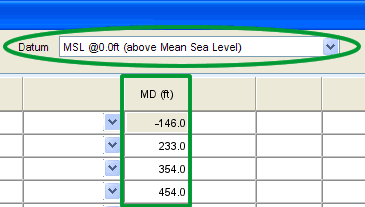Daily Workover Fluids Data
Interactive
Well Site > Available
Daily Operations Data
The Daily Workover Fluids form is used to track Oil,
Water and Other fluids injected, produced and non-recoverable volumes,
to determine the volume of fluids in tanks and fluids to be recovered.
Daily Workover Fluids data is recorded from the surface
and Daily
Operations link.
The Daily Workover Fluids form
allows uses to add, review, modify and delete workover fluids on a daily
basis.
For information on how to enter workover fluids data,
see the Recording
Daily Workover Fluids topic.
Special Fields and Functions
Fluid Pumped into Well Cumulative Fields
The application adds the oil, water and other
values to their corresponding Cumulative
(Cum) fields to display the total oil, water and other volumes
pumped into the Well to date. This calculation is reset to the current
day when the Zero Input Fluids
button is clicked.
Fluid Produced and Taken Off Location Cumulative
Fields
The application adds the oil, water and other
values to their corresponding Cumulative
(Cum) fields to display the total oil, water and other volumes
produced and taken off location to date. This calculation is reset to
zero when the Zero Load Fluids
Button is clicked.
Non Recoverable Annular Fluids Cumulative Fields
The application adds the oil, water and other
values to their corresponding Cumulative
(Cum) fields to display the total oil, water and other volumes
non-recoverable to date.
Fluid Produced to Tanks Calculation
The Fluid Produced To Tanks calculations
are affected by the FluidsToTanks
system setting.
When the system setting is set to NO (the
default), the values are entered as follows:
Vol Oil Surface
Tanks
Vol Other Surface
Tanks
Vol Water Surface
Tanks
When the system setting is set YES, the fields
are calculated as follows:
Vol Oil Surface
Tanks = Vol Oil Hauled On - Vol Oil Hauled Off - Vol Oil Non-Recover
+ SUM (Oil INPUT) - SUM (Oil PRODUCED)
Vol Other Surface
Tanks = Vol Other Hauled On - Vol Other Hauled Off - Vol Other Non-Recover
+ SUM (Other INPUT) - SUM (Other PRODUCED)
Vol Water Surface
Tanks = Vol Water Hauled On - Vol Water Hauled Off - Vol Water Non-Recover
+ SUM (Water INPUT) - SUM (Water PRODUCED)
Where from the Fluid in Hole Spreadsheet
INPUT and PRODUCED
volumes are defined as:
Oil Input = VolumeInput * (Oil
/ 100) |
Oil Produced = VolumeProduced *
(Oil / 100) |
Other Input = VolumeInput * (Other
/ 100) |
Other Produced = VolumeProduced
* (Other / 100) |
Water Input = VolumeInput * (Water
/ 100) |
Water Produced = VolumeProduced
* (Water / 100) |
Initial Load Fluid Volumes
This section displays the initial Oil, Water
and Other fluids recorded for the wellsite in the tab on the Event Properties dialog from the Well Explorer
window.
Zero
Input Fluids Button
Click this button to zero out the Fluid Pumped
into Well cumulative field values from previous reports. The cumulative
fields will begin accumulating the values beginning with the current report
until the Zero Input Fluids button
is selected again.
Zero Load Fluids Button
Click this button to zero out the Fluid to
Recover values. The Fluids to Recover
fields will begin accumulating the values beginning with the next report
until the Zero Load Fluids button
is selected again.
Fluids to Recover
Calculates volumes of Oil, Water (H2O) and
Other annular fluids entered in the Fluids in Hole spreadsheet.
Volume Oil to Recover = (Initial Load Fluid
Volume) Oil + Cum Vol Oil Hauled On - Cum Vol Oil Hauled Off - Cum
Vol Oil Non-Recover
Volume Other to Recover = (Initial Load Fluid
Volume) Other + Cum Vol Other Hauled On - Cum Vol Other Hauled Off - Cum
Vol Other Non-Recover
Volume H2O to
Recover = (Initial Load Fluid Volume) H2O + Cum Vol H2O Hauled On - Cum
Vol H2O Hauled Off - Cum Vol H2O Non-Recover
Import Well Tests
The Import Well Tests button allows users
to import test results from previous Test
reports into the spreadsheet.
Units Picklist 
The Unit Management System in the EDM™ database
controls display units in EDT™ applications. Every numerical element in
the EDM database has a storage measure (some known quantity in the physical
world) associated with it such as feet, ft/sec, or °F.
In OpenWells® software, Active Viewing Units
(or Display Units as they are sometimes referred to) are for presentation
purposes only. Display units can changed at any time and do not affect
the quality of the data.
Active Viewing Units for the OpenWells application
are selected from the Unit picklist
located at the top of each page.
Datum Selector 
The reference point for depths changes over
the life cycle of a Well, with changes in rigs and viewing data requirements.
The Datum Selector, located at the top of
each page, allows users to change displayed the depth reference point
(datum) on the fly.
Changing the depth reference point displays
depths relative to the datum selected. This DOES NOT change the values
in the database itself.
Data MUST be
entered correctly in context to the selected datum reference point.
The following example shows how the viewing
datum affects the data you see.


Print Page 
The Print Page button allows users to print
the current page as it appears in the window.
![]()
![]()


![]()